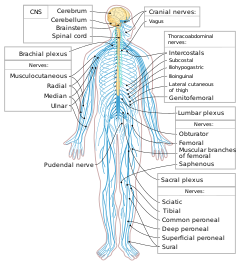Spinal cord
| Spinal cord | |
|---|---|

The spinal cord (in yellow) connects the brain to nerves throughout the body.
|
|
| Details | |
| Identifiers | |
| Latin | medulla spinalis |
| TA | A14.1.02.001 |
| FMA | 7647 |
|
Anatomical terminology
[]
|
|
The spinal cord is a long, thin, tubular bundle of nervous tissue and support cells that extends from the medulla oblongata in the brainstem to the lumbar region of the vertebral column. The brain and spinal cord together make up the central nervous system (CNS). The spinal cord begins at the occipital bone and extends down to the space between the first and second lumbar vertebrae; it does not extend the entire length of the vertebral column. It is around 45 cm (18 in) in men and around 43 cm (17 in) long in women. Also, the spinal cord has a varying width, ranging from 13 mm (1⁄2 in) thick in the cervical and lumbar regions to 6.4 mm (1⁄4 in) thick in the thoracic area. The enclosing bony vertebral column protects the relatively shorter spinal cord. The spinal cord functions primarily in the transmission of neural signals between the brain and the rest of the body but also contains neural circuits that can independently control numerous reflexes and central pattern generators. The spinal cord has three major functions: as a conduit for motor information, which travels down the spinal cord, as a conduit for sensory information in the reverse direction, and finally as a center for coordinating certain reflexes.
The spinal cord is the main pathway for information connecting the brain and peripheral nervous system. The length of the spinal cord is much shorter as compared to the length of the vertebral column. The human spinal cord extends from the foramen magnum and continues through to the conus medullaris near the second lumbar vertebra, terminating in a fibrous extension known as the filum terminale.
...
Wikipedia
